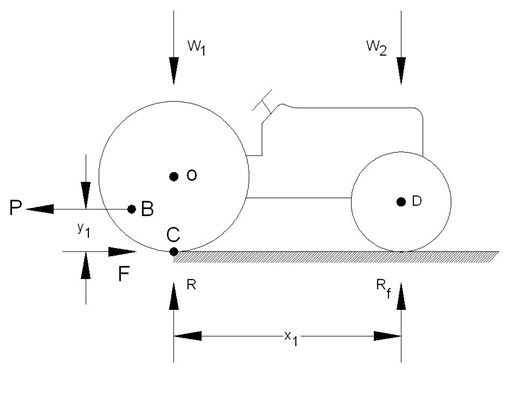Site pages
Current course
Participants
General
Module 1. Tractor Mechanics
Module 2. Traction
Module 3. Introduction to Transmission System
Module 4. Clutch System
Module 5. Gear Box
Module 6. Differential and Final drive
Module 7. Brakes
Module 8. Steering system
Module 9. Hydraulics
Module 10. Power Transmission
Module 11. Human Factors
Lesson 4. Analysis of tractor in static conditions
Analysis of a tractor:- Level surface and horizontal pull
Analysis of the tractor is done to measure the weight transfer coefficient due to pull exerted by a tractor while pulling an implement.
Fig. represents the various forces present on a tractor operating on a level horizontal surface with pull being horizontal and parallel to the direction of motion.
On the basis of the assumptions listed above, gravitation may be conveniently and satisfactory represented as shown in fig.1 by the weight W1, supported by the rear wheels, and the weight W2, supported by the front wheels, when the drawbar pull is zero. Likewise, the soil reaction can, for the purpose of this approximate analysis, be resolved into three components R1, R2, and F.

If the tractor is considered as free body, the algebraic sum of all forces acting parallel to the motion must equal zero:
F – P = 0 (1)
Likewise, the algebraic sum of all forces acting perpendicular to the direction of motion must equal zero:
R1 + R2 – W1 – W2 = 0 (2)
The algebraic sum of the moments about any given axis must equal zero. The problem is greatly simplified by summing moments about C, the intersection of the soil reactions R1 and F (fig.1). The line of action of force W1 also passes through this axis. The moment equation is:
W2 x1 – Py1 – R2x1 = 0 (3)
From these three equations the values of the soil reaction may be readily calculated in terms of the tractor’s weight and the drawbar pull.
Solving equation 3 for R2 :

And equation 2 for R1:
R1 = W1 + W2 – R2 (5)
Substituting the values of R2 from equation 4 for R2 in equation 5:
![]()
The stability of a tractor is, to a great extent, determined by R2 and the tractive capacity by R1.
The term expresses the change in soil reactions R1 and R2, resulting from the drawbar pull P. The soil reaction R1, supporting the rear wheels, increases as P increases and the soil reaction R2 decreases. This relationship is true until P becomes large enough to cause to become equal to W2, which in turn causes R2 to become zero. Any further increase in P will cause the front wheels to leave the ground.
Whether the tractor will become unstable and tend to turn over backward will depend on a number of factors, such as the location of the center of gravity of the tractor and the location of the hitch points to the tractor and to the implements being pulled. These factors are discussed later.
Although there is no actual shift of weight, this change in soil reactionsR1 and R2 is commonly known as weight transfer.
If zero is substituted for R2 in equation 4 and the equation is solved for P, an expression is obtained for the value of the drawbar pull P at which the soil reaction against the front wheel becomes zero.
![]()